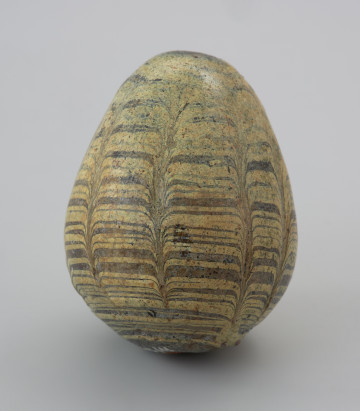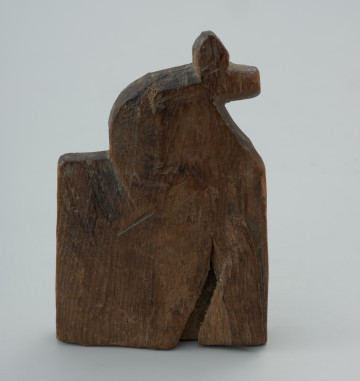
Rattle - Easter egg
National Museum in Szczecin
Part of the collection: Middle Ages
A stele - a stone slab with a schematic image of a human figure - is one of the most valuable early-medieval relics related to pagan Pomerania. It was found during the demolition of the remains of St. Peter's Church in Słupsk. According to historical data, this temple existed at the beginning of the 13th century, but its origins probably date back to the 12th century, the early period of Christianisation of West Pomeranian lands. The church was built on one of the hills on the right side of the Słupia River, at a Slavic settlement dating from the 8th to the 9th century. According to the doctrine of the Church, Christian temples were erected on pagan cemeteries destroyed during the Christianisation campaign. It may explain the presence of relief with a human image associated with pre-Christian Slavonic beliefs in the ruins of the church. The settlement on the Słupia River developed successfully in the following centuries. In the second half of the 13th century, the town grew out of a Slavic settlement complex and was granted town rights. St. Peter's Church was thoroughly rebuilt in the Gothic style in the 14th century, and a stone stele was built into one of the walls. Similar cases are known from the close vicinity of Bergen and Altenkirchen on the island of Rügen, Wolgast (Wallachia) in Vorpommern and Sadlna in West Pomerania. The images on the slabs are usually interpreted as representations of pagan gods or grave slabs. The Słupsk stele found in the 1860s was transferred to the collection of the Society of History and Antiquities of Pomerania in Szczecin in 1892. In 1927, it was added to the Provincial Museum of Pomeranian Antiquities (from 1934, functioning as the Pomeranian National Museum). Currently, it is in the collection of the National Museum in Szczecin.
Anna Bogumiła Kowalska
Author / creator
Dimensions
cały obiekt: height: 126 cm, width: 66 cm
Object type
cult object
Technique
bas-relief, bas relief, masonry
Material
stone
Origin / acquisition method
acquisition
Creation / finding place
Owner
Muzeum Narodowe w Szczecinie
Identification number
Location / status

National Museum in Szczecin

National Museum in Szczecin

National Museum in Szczecin
DISCOVER this TOPIC
Museum of King Jan III's Palace at Wilanów
DISCOVER this PATH
Educational path